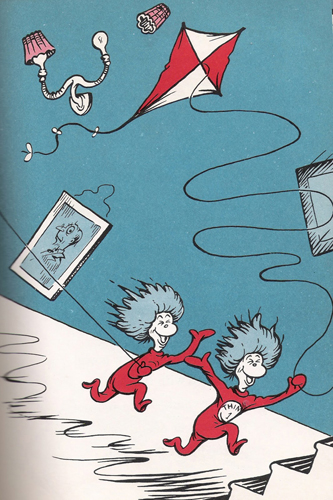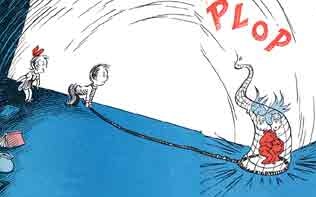…or How to Keep Your Website Development under Control
Everybody loves the The Cat in the Hat – well, maybe not EVERYbody, but we’ll just pretend that most people have good taste. Think about the character the Cat in the Hat – he’s fun; he’s energetic; and he owns an awesome hat (you can buy one here, if you’re so inclined). Plus he has some really fun things – Thing 1 and Thing 2, just to mention a few.
But if you take a moment to think about the Cat in the Hat, he’s actually not that great. That Cat is a MESS. Imagine having the Cat in the Hat at your office every day. Productivity would probably come to a standstill – unless your company defines productivity as juggling and running around with kites.
That said, the Cat in the Hat actually does pop up in work environments all the time. Seriously, he’s standing behind me right now. Watching every word I type. It’s actually kind of creepy. Oh, nevermind, that’s just my co-worker Tim dressed up in a cat suit.
Anyway…I’m not lying when I say that the Cat in Hat shows up in the work place, though it would probably be more accurate to say that the spirit or attitude of the Cat in the Hat shows up. We see it all the time in the web development projects we do. A client has a plan, an idea, that we map out. It’s perfect – until the client decides to throw in some milk and cake, a few books, and a fish on rake. Not to mention a toy ship with a little toy man. But that’s not all – oh no! Then they actually ask us to hop on a ball. Not much, just a few little hops here and there. Surely we can do it. There’s no way we can fall.
It’s completely DO-ABLE, if you know anything at all.
This blog is not a rant about client projects – I promise. Instead, what I want to do is give you a couple of tips so your website turns out as awesome as possible without causing you (many) frustrations or headaches. Here are 2 things that will make your web development project (or any project) easier for you:
1. Stay Focused
2. Keep Your Team under Control
1. Stay Focused
– Make a list of everything that NEEDS to be on your website. If you sell products online, then clearly a shopping cart is a must.
– Make a list of things you would like to have – features that help the end users but aren’t actually necessary for your business to function online.
– Keep a running list of new features you would like to add that occur to you during the web development process (after the initial contract or proposal has been signed).
Keeping this list will not only help keep your goals clearly in sight, but it will help you keep your budget under control. Perhaps there are some website features you would like to have, but they drive the cost up too high. For instance, maybe you want to incorporate a large, dynamic graphic slider on your homepage, but it eats up a large chunk of your budget. Don’t get overwhelmed by this one item. It doesn’t mean you need to scrap the whole website. Set aside that extra feature for now and implement it at a later point when you have more funds available to make website changes again. For now, stick with a static image that still resonates with your users but is much easier on your pocketbook.
The third point on the list – features that occur to you during the web development process – is also key to staying on budget. Many clients expect their new websites to include anything they can think of – no matter how many extra items that may be. However, if you come up with 10 new features that you didn’t mention at the start of the project, don’t be surprised when the cost of the website increases from what was originally estimated. Once again, you’ll have to decide if these are features that you and your end users absolutely NEED on the website or if they are things you would just like to have. If they fall into the latter category, you can save on costs and implement them at a later point.
Aside from budget concerns, ask yourself if certain features you’re interested in including will truly improve the user’s experience. If it will, include it. If it won’t, put it on the chopping block. Sometimes having too many “cool” features can end up creating too much noise for the users, and they actually hurt the website’s performance and usability. Keep your end user in mind and avoid adding features that are just for show. Otherwise, all that fancy juggling could lead to this:
And let’s face it – having your website collapse on potential customers probably won’t garner you much business.
2. Keep Your Team under Control
With small business looking to revamp their websites, this isn’t so much of an issue. However, larger companies often have committees representing the interests of different groups in a website project. When revamping the company’s website, it’s important to get feedback and keep people within your company engaged, but you also have to remember point #1 – STAY FOCUSED. When you open up the project to outside comments, you can receive a lot of great feedback. Some of it might be great and make sense to implement into the website. However…
How do you do?
Would you like to shake hands
With Thing 1 and Thing 2?
They’re so nice and friendly, and they have the best intentions. They’re going to give us GREAT feedback!
However, trying to cater to too many voices can also cause you to lose focus. Though trying to help, they cause chaos instead:
We’ve had different clients who wanted to completely change their websites to have a clean, fresh look. By the time they accommodated everyone’s opinion in the new design, they often end up with a cluttered look that’s similar to worse than the old one.
When the ideas getting thrown around start to compromise your main goals, you need to do this:
Get your team under control. Thank them for their feedback and, if you think it’s necessary, explain how certain input helps bring the website project closer to the final goal while other commentary does not. If you let team members have too much free rein in their opinions, they can quickly get out of hand. Be specific about the kind of feedback you’re looking for, and don’t afraid to be firm if people start to cross the line.
In the end, keeping your focus on the main goals for the new website and keeping your team on track with you will help your website project stay on schedule and accomplish the overall company goals that have been set.








